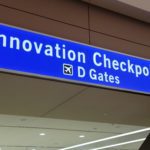
Air travel was one of the industries hit hardest during the COVID-19 pandemic. Traffic plummeted as countries closed their borders to control the spread of the disease, and lockdowns limited the appeal of most destinations for anyone who could get on a plane.
Thankfully, there are signs that the industry is starting to recover. Travel volumes have steadily picked up in the second half of the year, and the increased availability of vaccines (and vaccine boosters) has created cause for optimism despite the ongoing spread of COVID variants.
Recent technological advancements are also playing a key role in that recovery. Improved screening technologies help airports process passengers more quickly, and (more importantly) allow them to do so while still keeping people safe during a pandemic.
Many of those technologies were on display at the Future Travel Experience (FTE) Global conference earlier this month, and we were able to get a look at many of the highlights from the show floor. With that in mind, here are four key trends that will shape the future of air travel for people all over the world:
Identity is the Future
Identity was the leading topic of conversation at FTE. From document readers to self-service kiosks to gates outfitted with facial recognition cameras, air industry stakeholders are trying to come up with faster and simpler ways to identify people getting onto flights.
In that regard, a complete end-to-end identity system is made up of several disparate parts, all of which were represented at FTE. HID Global and Regula were focused primarily on document scanners, while Corsight and Paravision were showing off contactless facial recognition systems. Meanwhile, companies like IDEMIA, NEC, Vision-Box, and SITA are trying to put all of the pieces together to link a passenger’s biometrics to their identity document and deliver a more streamlined passenger journey.
Regardless of the specific use case, the goal remains the same. The air travel industry wants to process more people in a shorter amount of time, and it is taking steps to do that while traffic volumes are still down during the pandemic.
The results of those efforts should become more evident in the next few years. Facial recognition and self-service stations will become even more widespread than they are now, and there will be more and more mobile apps (such as Airside’s identity platform) being integrated into the passenger experience. Those apps will allow people to start the identification process at home, which will speed things up even more when they do get to the airport.
Clear the Path
While most of the identity technologies on display at FTE can make airports more efficient, most of them also still fit within the parameters of a more traditional passenger journey. In plain terms, that means that they still ask people to stop at obvious high-friction checkpoints (such as self-service kiosks or boarding gates) to complete either a face or a document recognition scan. Each one of those stops could become a potential chokepoint if enough people are trying to get through at the same time.

With that in mind, it’s worth calling attention to the high-throughput facial recognition solutions that could transform the way that people move through airports. Both Corsight and Paravision are trying to replace more traditional gates and turnstiles with completely frictionless corridors that are so unobtrusive that the people walking through them would not even know that they are being scanned.
In practice, that means that airports would be able to mount small cameras on the walls of a hallway, and those cameras would authenticate passengers (and match them to their flights) as they walk down the hallway in real time. Those passengers would need to be registered in the system before getting to the airport or at check-in. However, they would not need to stop for any secondary inspections as they walk through the airport and board their flights.
The Paravision and Corsight tech is fast enough to identify dozens of people simultaneously, and robust enough to generate matches at challenging angles, and when people are wearing masks. That’s why it has the most potential to completely upend the legacy airport experience. Frictionless facial recognition would theoretically allow airports to remove some of their physical security hardware, without creating any new vulnerabilities in their security posture. The technology probably won’t be deployed at scale for a few more years, but its presence at FTE is a telling indicator of where the travel industry is headed with regards to screening.
Rules and Regulations
One of the recurring themes at FTE was that most of the technology on display is already good enough to deploy. The document scanners can read documents. The cameras can read faces. And if it is all integrated properly, it will create a dramatic improvement for most travelers.
Unfortunately, that scenario is unlikely to play out anytime soon. Most of the technologies still need to get certified by organizations like the TSA and other government agencies around the world, and the vendors selling those technologies still need to persuade airports and airlines to invest in next-generation infrastructure.
In other words, technological development is not going to be the biggest challenge for air travel stakeholders in the next few years. Rather, the challenges will be working with regulators to get the technologies that already exist certified and approved for use at scale. Developers also need to convince buyers and the general public of the value those technologies bring to airport operations. Overcoming those obstacles will take time, and will slow the rate of digital transformation as new technologies make their way through that regulatory bureaucracy.
Running a Temperature
One of the other noteworthy takeaways from FTE is what wasn’t there. While many vendors were showcasing some kind of passenger processing technology, none of them were pushing any kind of thermal screening tech. Many companies introduced temperature detection systems in early 2020, in most cases pitching them as an effective COVID-19 detection method. However, the technology was entirely absent from the FTE show floor in 2021, and it did not even come up in most discussions about the future of air travel.

Of course, that’s not all that surprising now that doctors know more about the coronavirus. While fever is a common symptom of COVID-19, it can also be a symptom of many other diseases. More importantly, thermal scanners will not catch infected people who are either pre- or asymptomatic, which limits their utility as a COVID-19 screening measure.
That fact that the world’s leading air travel stakeholders are so totally disinterested in temperature screening suggests that the tech was a fad rather than a trend. Airlines and airports are still trying to mitigate the spread of COVID-19, but are much more likely to rely on actual COVID-19 test and vaccination results rather than spurious temperature scans.
***
The technologies on display at FTE Global should help restore trust between travelers and travel stakeholders, which should in turn make consumers feel more confident the next time they want to book a trip. That shift will be vital to the long-term recovery of the industry. If FTE Global is any indication, the industry will be ready when the world decides to return to the skies.
–
December 22, 2021 – by Eric Weiss






Follow Us